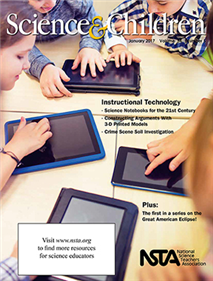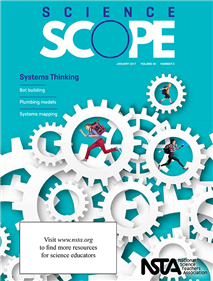All Resources
Journal Article
Constructing Arguments With 3-D Printed Models
Fourth-grade students model the external structure and function of bottom-dwelling fish....
Journal Article
Crime Scene Soil Investigation
Fifth graders use mobile learning to solve a “crime.”...
Journal Article
Science Notebooks for the 21st Century
Going digital provides opportunities to learn with technology rather than from technology....
Journal Article
Get Ready for the Great American Eclipse!
A once-in-a-lifetime event provides an opportunity to increase science literacy....
Journal Article
Technology aids second-grade students in data collection....
Journal Article
Editor's Note: The Dilemmas of Technology
Science and Children’s editor shares thoughts regarding the current issue....
Journal Article
The Poetry of Science: Think It, Build It, Make It
Building literacy in playful, meaningful ways. This issue discusses inventing with technology....
Journal Article
The Early Years: Integrating Digital Tools
This column discusses resources and science topics related to students in grades preK to 2. This month’s issue talks about how digital media and robotics fit into the early childhood curriculum....
Journal Article
Teaching Through Trade Books: Teaming Up: Trade Books and Technology
This column includes activities inspired by children’s literature. This month’s trade books teach students about external and internal structures that allow animals and humans to survive....
Journal Article
Engineering Encounters: Optimizing Your K–5 Engineering Design Challenge
This column presents ideas and techniques to enhance your science teaching. This month's issue discusses the optimizations that will serve to inform readers of seven recommendations for optimizing an engineering lesson....
Journal Article
Methods and Strategies: Using Argument-Based Inquiry Strategies for STEM Infused Science Teaching
This column provides ideas and techniques to enhance your science teaching. This article focuses on an argument-based inquiry (ABI) approach to a fourth-grade unit on waves. A fourth-grade teacher included multiple opportunities for students to rea...
Journal Article
Using Systems Mapping to Plan Scientific Investigations
Learn how to map mental models that students use to explain how the world works....
Journal Article
Building Bots to Develop Systems Thinking
Construct a scribble bot and determine how each part functions to form a system....
Journal Article
Build a submarine to explore how the density of an object affects its ability to float and sink....
Journal Article
Call the Plumber! Engaging Students With Authentic Engineering Design Practices
Explore the plumbing of a house to build an optimal physical model of the system....
Journal Article
Classic Lessons 2.0: Falling Into Understanding
This column shares updated perennial classroom favorites. In this lesson, seventh-grade students explore falling objects and try to explain why objects fall. Using a local university’s extensive exhibit on Galileo (see Resources), the teachers also...
Journal Article
Teacher's Toolkit: Using Rubrics to Integrate Crosscutting Concepts
This column provides how-to strategies and practical advice for the science teacher. This month’s issue explains the development of a rubric that may serve as a bridge between the learning outcomes associated with specific crosscutting concepts and...
Journal Article
From the Editor's Desk: Systems Thinking Solutions
Science Scope’s editor shares thoughts regarding the current issue....
Journal Article
Citizen Science: Ecosystems and Eagle Populations
This column highlights formal and informal science research projects that students can join and contribute to by gathering and sharing data. Soar into systems thinking with the Mid-Winter Bald Eagle Survey....
Journal Article
Disequilibrium: A Balancing Act
This column shows how to use discrepant events to confront misconceptions. This month’s discrepant event helps students identify and develop an understanding of the simple relationships between various components of a system. Students will find th...
Journal Article
Listserv Roundup: From the Archives: Systems
This column shares recent conversations taken from the NSTA listserv community about current science education topics. In this month’s column we dive into the NSTA listserv archives and look at some requests for resources on understanding and teach...
Journal Article
Science for All: Going From Macro to Micro
This column shares strategies for increasing student engagement. In this month's issue we discuss how you can use the theory of multipe intelligences to provide differentiation for your students....
Journal Article
Teacher to Teacher: Assessing Crosscutting Concepts
This column provides practical advice from your peers. Cross Cutter Cards provide a method for students to apply a crosscutting concept when discussing similarities between two different phenomena....
Journal Article
Scope on the Skies: Flipped Constellations
This column focuses on astronomy throughout the year. This month’s issue discusses constellations....
Journal Article
Integrating Technology: Students Making Systems Models: An Accessible Approach
This column shares how teachers use technology for assessment, student learning, or classroom management. Teaching and learning about systems can be challenging without the right tools and curricular supports. The authors developed a tool to support ...
Journal Article
Planning rich reading experiences that support language development and science learning....
Journal Article
Editor's Corner: Digital Literacy—Is It Real?
The Science Teacher’s editor shares thoughts on the current issue....
Journal Article
Science 2.0: Help Students Become Innovative Designers
This column shares web tools that support learning. The past three columns have described how teachers can implement the first three Empowered Learner Standards established by the International Society for Technology in Education. This month, the aut...





